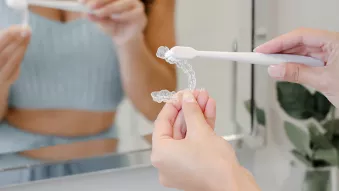What To Do If Your Aligners Are Not Fitting

In the past, the only way to fix evident malocclusions was with the traditional metal braces. However, technological advancements these days have given us a new option: clear aligners. These aligners are less noticeable than their metal counterpart and enable you to have a confident, beautiful smile throughout treatment.
The biggest difference with clear aligners vs traditional braces is that you can remove them when you are eating, drinking, or brushing your teeth. This flexibility can be great, but can also lead to problems during treatment if not monitored carefully. For many patients, they get so used to having them out that they forget to put them back in when they are done, which can lead to aligners not fitting correctly anymore. Luckily, our Spark Aligner Providers are the perfect resource to help you figure out what to do when your aligners don’t fit.
Reasons For Aligners Not Fitting
Aligners that fit well should feel snug against your teeth, especially when you first start treatment or switch to a new tray. Sometimes there may be a slight space in certain areas where the teeth may be shifting, but those gaps should fill in after a few weeks of wear. However, if your aligners are extremely painful or feel loose, you should consult with your doctor to see if there is an issue. Some of the main reasons your aligners could get off track are:
- There is insufficient pressure on certain teeth – Different types of teeth need different amounts of pressure to get the desired movement. If the pressure on these teeth isn’t sufficient enough, the teeth will not move into place properly. This can be easily fixed by adding attachments or elastics to the treatment plan to help create the right amount of pressure on the teeth.
- There is not enough space for teeth to shift properly – Sometimes your teeth may be too crowded or certain movements may be causing them to come together during the process. If this is the case, your orthodontist may look for ways to help create enough space so your teeth can shift comfortably.
How To Solve The Problem Of Aligners Not Fitting
The best thing to do if you feel like your aligners aren’t fitting right is to contact your orthodontist and inform them about the issue. They may be able to provide you with some of these easy solutions to help fix aligners that don’t fit.
Give Them Some Time To Settle In
As we mentioned, the first time you start wearing aligners, you might feel as though they don't fit properly, even if they do. The best way to fix this problem is by making sure to wear your aligners for approximately 22 hours a day. Since you are taking your aligners out when drinking, eating, or brushing your teeth, it can be easy to forget to put them back in again. But, making it a habit to wear them as much as possible will ensure your treatment goes smoothly. If you don't wear the aligners as prescribed, they may no longer fit right, which can cause the treatment process to take significantly longer than originally planned.
Do Chewing Exercises
A good way to help fix the problem of aligners not fitting properly is with chewing exercises. Chewing helps strengthen your jaw muscles and can be an effective way to get your aligners fitting better. These exercises are usually focused on the front teeth since those do not get as much pressure as the molars. For most patients, doing these exercises 3 to 5 times a day for 3 to 5 minutes is enough to help get their aligners back on track. You can either use soft plastic cylinders, known as chewies, or special mints that provide a safe, edible way to help aligners sit properly. Chewing exercises are also effective in relieving any discomfort you might have when you start using aligners for the first time.
Get An Updated Treatment Plan
In some situations, patients can experience severe pain or discomfort if their aligners are not fitting correctly. This usually happens when the teeth don't move as fast as your doctor expects. Even with technological advances, everyone’s bodies are different and teeth can behave in unpredictable ways. Talking to your orthodontist and getting an updated treatment plan can be a good idea if you have concerns with how your aligners are fitting. In many cases, they can adjust or replace your aligners if they don’t fit properly. They will also be able to tell you whether it’s a quick fix, such as using an old set longer than initially planned, or something that will require more time and patience.
Look Forward To A Beautiful Smile
In most cases, aligners not fitting properly can be fixed with a few at-home solutions or your orthodontist's advice. The best thing you can do is stay positive and follow all directions as carefully as possible. If you have any questions or concerns, contact our Spark Providers for help and get your smile back on track today.




